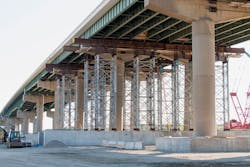Mabey’s Temporary Shoring System Allows I-495 Bridge to Remain Operational During Construction
When the I-495 bridge in Wilmington, Del., was discovered to have severely leaning piers and was abruptly shut down to traffic, a remarkable team effort among the public, government agencies, and private construction companies and suppliers safely stabilized the bridge using Mabey Inc.’s structural towers, averting a potential disaster and reopening the bridge to traffic within two months of the closure.
More than 90,000 commuters use the I-495 bridge over the Christina River each day, and when the bridge shutdown occurred on Jun. 2, it caused major traffic delays and congestion. Rerouted traffic not only inconvenienced commuters but also diverted semi trucks into neighborhoods whose infrastructure could not accommodate such large vehicles. Reopening I-495 quickly was imperative, but safety remained the priority.
The warning bells started when the public noticed a set of 48-ft piers tilting under the bridge and reported it to DelDOT. After engineers examined the bridge and deemed it unsafe, it was shut down immediately. DelDOT ordered an around-the-clock emergency repair plan and federal officials approved aid up to $40 million. The cause of the leaning piers was determined to be 55,000 tons of dirt that had been stockpiled near the bridge by a contracting and hauling company that created compression around the foundation and compromised the integrity of the structure.
Immediately after the bridge was shut down, J.D. Eckman Contractors was called into an emergency meeting with DelDOT and other agencies to discuss options. Engineers from AECOM, J.D. Eckman, DelDOT, FHWA and Mabey were involved in decision points for the plan.
“The total tilt in the piers was bad; the parapets were 17 in. higher in the one area than the others,” said Greg Burkhart, PE, J.D. Eckman.
The plan called for swift action and expertise from suppliers, contractors, and government entities. A multistep plan was constructed to stabilize and support the bridge, reopen lanes to traffic, and finally repair the damaged piers. Many suppliers were involved in this project, totaling more than 100 workers, and the specifics of the plan were based on availability of materials, expertise in the field, and the attributes of specialized equipment. Mabey’s MAT75 Tower System was a big part of that plan.
After the ground and bridge piers were stabilized using tie rods, cables, tilt meters and inclinometers, Mabey Inc.’s Bridging & Shoring Manager, Jim Porreca, was contacted to provide the temporary support towers, beams and hydraulic jacking system for the project.
“Mabey had the appropriate towers for this job. The MAT75 tower can be made 5 ft wide and the grade beam was only 6 ft wide, so the Mabey towers fit within the dimensions of the grade beam we were using,” commented Joseph Rovnan, PE, J.D. Eckman.
Mabey delivered 16 MAT 75/125 towers and support beams, 64 support tower grillage beams, 12 100-ton L/N cylinders and four 150-ton L/N cylinders to the bridge site. Mabey’s pre-engineered tower system bolts together on-site and does not require welding or special fabrication. The tower system is capable of supporting approximately 200,000 lbs per leg, and the adjustable screw units can be placed on the tower legs to help with leveling and height adjustment.
J.D. Eckman installed the towers alongside the leaning piers to reinforce support to the bridge, and sensors were used to monitor and test the stability of the roadway. Six DelDOT trucks, loaded with wet sand, were driven to—and stopped over—the damaged spans where the support towers took on the weight. DelDOT was able to reopen the northbound side of I-495 on Aug. 23, while the southbound lanes were reopened on Jul. 31. Diligent work by contractors, suppliers and DelDOT, along with the safety and stability provided by Mabey’s MAT 75/125 tower support system, contributed to reopening I-495 a month ahead of schedule.
With the operation of the bridge restored, the laborious task of the demolition and rebuilding of the four damaged piers began immediately. Beginning with the dissection of the hammerhead top of each pier, sections of the pier are removed a slice at a time, until Eckman’s 275-ton crawler crane could reach into the space between the Mabey towers to grab and remove substantial pier sections. This process will take at least a month to complete. Once the piers are removed, it will take another few weeks to form and pour new pier foundations between the grade beams. The new structure will consist of three columns per pier for a total of six. Mabey’s towers will be in place until the project is complete, forecasted for the end of the 2014.
